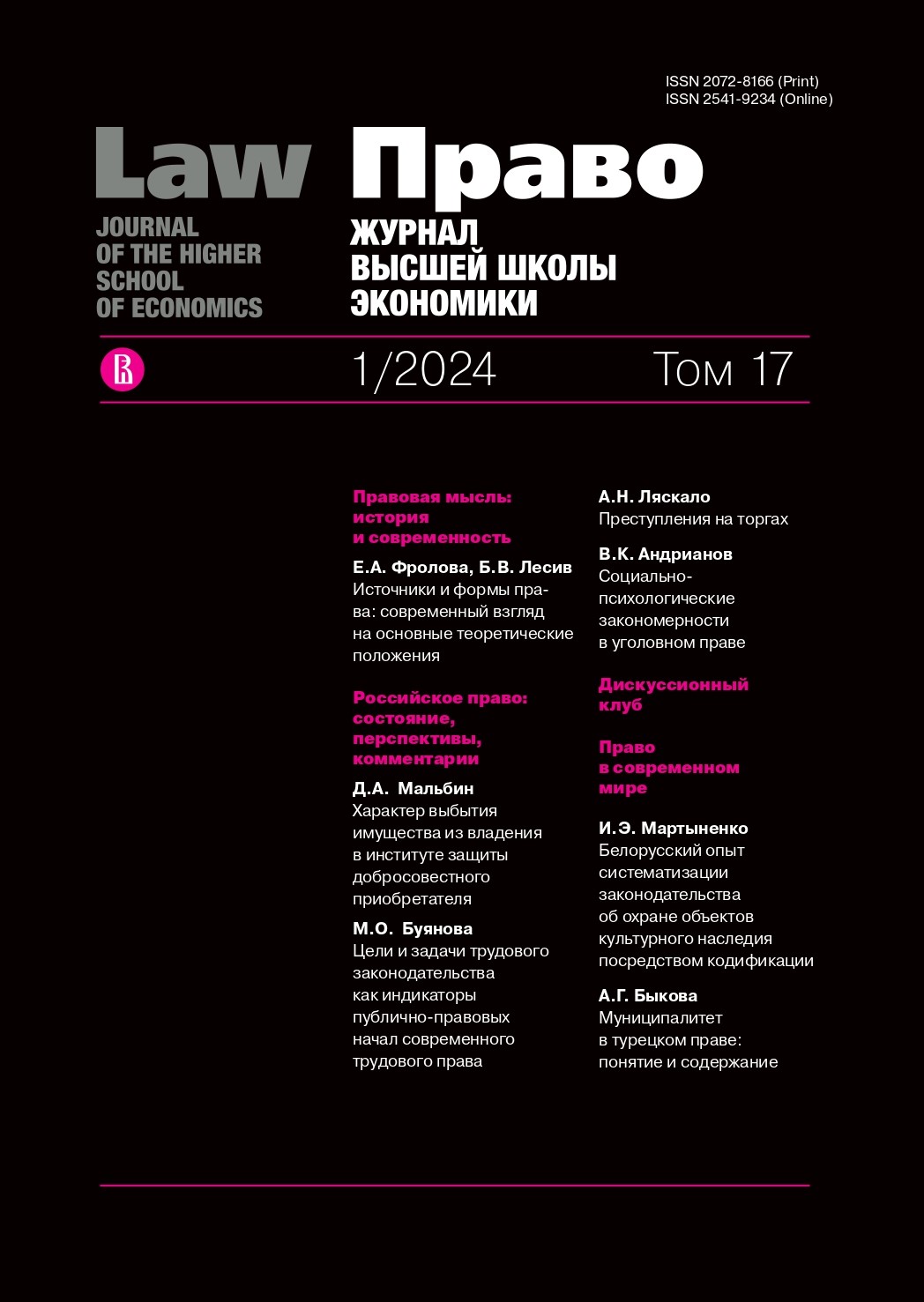Белорусский опыт систематизации законодательства об охране объектов культурного наследия посредством кодификации
Аннотация
Цель статьи — ознакомление юридической общественности с первым опытом кодификации законодательства о культуре и практикой его применения. В предлагаемой статье рассматриваются особенности реформирования законодательства об охране объектов культурного наследия посредством его кодификации. Автор, основываясь на анализе положений Кодекса Республики Беларусь о культуре, введенного в действие в 2017 г., и конституционных изменений 2022–2023 гг., раскрывает преимущества и недостатки кодификации данной сферы законодательства. Доказывается, что кодификация законодательства о культуре позволила упорядочить многочисленные нормативные правовые акты, действовавшие в области культурного (историко-культурного) наследия, музейной, библиотечной и градостроительной деятельности, направленной на сохранение и использование объектов культурного наследия. В статье излагаются новеллы регулирования права собственности на объекты культурного наследия, в том числе, памятники археологии, археологические артефакты, клад, а также принудительного прекращения права собственности посредством судебного изъятия бесхозяйственно содержимых памятников. Приводятся примеры решения проблемы финансирования в сфере культурного наследия за счет использования новых инструментов (меценатов и спонсоров, государственно-частного партнерства). Определенное внимание уделено судебной защите объектов культурного наследия (историко-культурных ценностей), новое решение которой предложено в Кодексе о культуре. В статье сформулированы некоторые предложения по уточнению правового статуса недвижимых памятников и движимых культурных ценностей, приводится классификация материальных и нематериальных историко-культурных ценностей по видам. Излагаются структура Государственного списка историко-культурных ценностей и особенности его ведения с 1 января 2023 г. Статистические данные в динамике конкретизируют исследовательский материал и позволяют улучшить его восприятие. Автор отстаивает идею, что принятие Кодекса о культуре создало предпосылки для формирования принципиально нового подхода к государственной охране, учету и использованию в современной жизни памятников старины и искусства. В этом плане белорусский опыт кодификации законодательства о культуре может быть полезен.
Литература
Bartkova O.G. (2022) Relationship of the category “culture” and the basic concepts in the field of legal regulation of cultural activities with individual institutions of civil law. Vestnik Tverskogo gosudarstvennogo universiteta=Bulletin of Tver State University, no. 3, pp. 7-14 (in Russ.) DOI: https://doi.org/10.26456/vtpravo/2022.3.007
Bistrova O.A. (2016) The essence and content of public administration and regulation in the sphere of culture. Kultura: upravlenie, ekonomika, pravo=Culture: Management, Economics, Law, no. 1, pp. 29-33 (in Russ.)
Goloviznin A.V. (2019) Security obligations as encumbrances imposed on owners of cultural heritage objects. Kultura: upravlenie, ekonomika, pravo=Culture: Management, Economics, Law, no. 3, pp. 29-35 (in Russ.)
Goloviznin A.V. (2022) Social and legal aspects of investing in cultural heritage objects (Sverdlovsk area case). In: Financial and legal aspects of socially oriented investment: papers of All-Russian conference. Yekaterinburg: Ural State University of Economics, pp. 159-163 (in Russ.)
Ivanova Zh.B. (2020) Irreparable losses of cultural heritage: on the issue of the effectiveness of protective obligations. Kultura: upravlenie, ekonomika, pravo=Culture: Management, Economics, Law, no. 3, pp. 36-40 (in Russ.)
Klebanov L.R. (2020) Art market: aspects of legal regulation. Moscow: Norma, 232 p. (in Russ.)
Kuzina S.V. (2017) Novellas in the field of historical and cultural monuments protection. Vestnik Saratovskoi yuridicheskoi akademii=Bulletin of Saratov State Law Academy, no. 4, pp. 135-139 (in Russ.)
Kulikova S.A. (2022) Protection of historical memory as an institution of constitutional law: Russian and foreign experience. Izvestiya Saratovskogo universiteta=Bulletin of Saratov University, no. 1, pp. 65-72 (in Russ.) DOI: https://doi.org/10.18500/1994-2540-2022-22-1-65-72
Lavrov V.V. (2016) Prosecutor's supervision over the execution of laws on the protection of cultural heritage objects: Candidate of Juridical Sciences Thesis. Moscow, 238 p. (in Russ.)
Melnichenko N.N. (2022) Criminal law protection of archaeological heritage: theoretical, legislative and law enforcement aspects: Candidate of Juridical Sciences Thesis. Krasnodar, 225 p. (in Russ.)
Mozhaeva I.P. (2020) The main directions of countering criminal encroachments at cultural values. Pravo. Zhurnal Vysshey shkoly ekonomiki=Law. Journal of the Higher School of Economics, vol. 13, no. 3, pp. 72-89 (in Russ.) DOI: https://doi.org/10.17323/2072-8166.2020.3.72.89
Neshataeva V.O. (2018) Modern threats to cultural values and the role of the EAIS in their protection. Rossiyskoye pravosudie=Russian Justice, no. 11, pp. 100-109 (in Russ.) DOI: https://doi.org/10.17238/issn2072-909X.2018.11.100-109
Panfilov A.N. (2023) Countering illegal archaeological activity in the Russian Federation: regulation and practice. Moscow: Norma, 210 p. (in Russ.) DOI: https://doi.org/10.12737/1894394
Redchits M.A. (2018) Criminal law protection of cultural heritage objects: Candidate of Juridical Sciences Thesis. Moscow, 222 p. (in Russ.)
Vidineev D.I. (2017) Progressive development of the Institute of International legal protection of cultural values: Candidate of Juridical Sciences Thesis. Moscow, 233 p. (in Russ.)
Copyright (c) 2024 Право. Журнал Высшей школы экономики

Это произведение доступно по лицензии Creative Commons «Attribution-ShareAlike» («Атрибуция — На тех же условиях») 4.0 Всемирная.


















